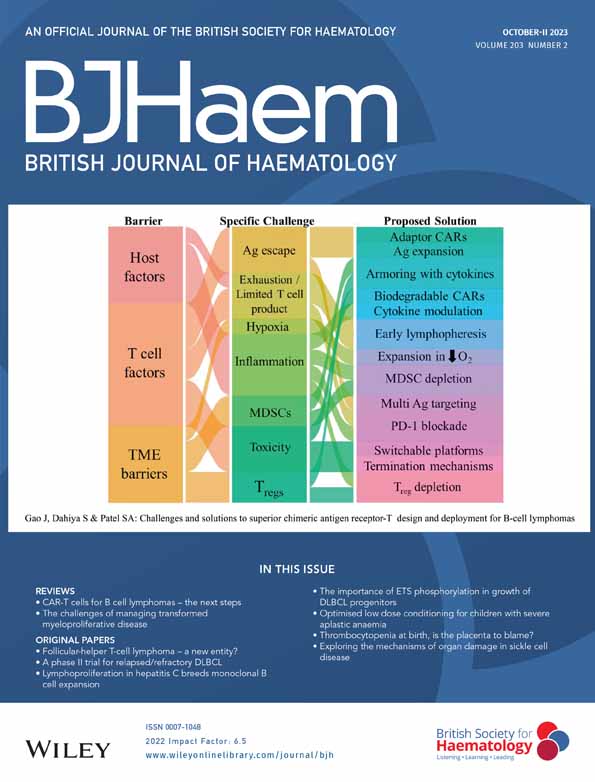Paging all ENT specialists: Sinus manifestations of Erdheim–Chester disease
Commentary on: Drouillard et al. Sinonasal and ear manifestations of Erdheim–Chester disease. Br J Haematol 2023;203:194-201.
In their paper, Drouillard et al.1 present the data from a retrospective study examining a large cohort of patients with Erdheim–Chester disease (ECD) who had available data for clinical and radiographic evaluation of sinuses and ears. These findings add to the list of unique manifestations of this rare disease and have clinical implications for practising ENT physicians and radiologists alike.
Our understanding of ECD has come a long way over the last decade with the discovery of MAPK/ERK pathway mutations in most cases, eventually leading to the recognition of this entity as a haematopoietic neoplasm and approval of targeted (BRAF and MEK) inhibitors.2 However, ECD remains a disease that is difficult to diagnose owing to its diverse manifestations mimicking a multitude of diseases and non-specific biopsy findings.2-4 In the last few years, many manifestations have been recognized as classic for ECD, such as bilateral osteosclerosis of knee bones (distal femur, proximal tibia/fibula), perinephric infiltration (hairy kidney), sheathing of aorta (coated aorta), central diabetes insipidus, right atrial pseudotumor and periorbital xanthelasma.5 Per existing guidelines, these findings in combination with biopsy evidence of foamy histiocytes with or without detectable MAPK/ERK pathway mutations can lead to a diagnosis of ECD.2 Several studies have examined the prevalence of sinus involvement in ECD based on imaging (~50%),5, 6 but a comprehensive description of the characteristic radiographic or clinical features in such instances was largely lacking.
In this study, Droulliard et al. examined a cohort of 162 individuals with ECD who had available clinical or radiographic data for sinonasal and otologic evaluations and found 75.2% to have abnormalities suggestive of involvement by ECD.1 The data included in the analysis were mainly radiologic (92%), and most of the attribution to ‘ENT’ involvement was in the form of radiographic sinus abnormalities. A unique manifestation that the authors found was maxillary sinus frame osteosclerosis seen in 47 of 149 (31.5%) patients with imaging data, a finding that they pose could be characteristic of ECD. In multivariable analysis, the authors found that sinus involvement was associated with BRAFV600E mutation, but not with central nervous system disease or diabetes insipidus.
There are several caveats to the data presented in the manuscript. The inclusion of patients with ‘ENT’ data to study the prevalence of sinus and otologic manifestations introduces a huge element of selection bias as those evaluations were likely conducted due to clinical concerns. There is a need for studies that conduct uniform imaging at diagnosis to assess the true prevalence of organ involvement in ECD. The authors' estimate of 45% seems to be a more reasonable proportion of the prevalence of sinus abnormalities in ECD when they use their entire ECD cohort of 272 patients as the denominator. Further complicating the picture is that only a very small subset of their cohort (15 of 162 [9.2%]) actually underwent a diagnostic biopsy, and further, only 10 of them (66.7%) were positive for ECD. Therefore, it is unclear whether mere sinus thickening on radiographic imaging equates to ECD involvement, especially since it can be seen in a large proportion (>50%) of asymptomatic general population.7 However, maxillary sinus osteosclerosis appears to be a more specific finding noted by the authors in a subset of their cases, and the question arises whether it can be added to the list of ‘hallmark’ or classic manifestations of ECD to aid in diagnosis.
Given the delay in diagnosis of ECD ranging from months to years of symptom onset, every attempt should be made to identify characteristic features that by themselves or in combination with other features can lead to the diagnosis. Patients with ECD visit many doctors depending on organ manifestations and do not see a haematologist/oncologist until the diagnosis is made. Therefore, multidisciplinary education is critical to capture early and accurate diagnosis at the patient's each point of contact with health care.8 Although the study by Drouillard et al. does not provide these data, it is entirely possible that many patients with ECD are seen in the ENT clinics due to sinus symptoms prior to diagnosis. Knowledge among ENT physicians regarding the finding of maxillary osteosclerosis in ECD could lead them to inquire about other signs and symptoms of the disease, thereby conducting additional radiographic testing (PET/CT scan) for identifying other classic features (Figure 1) and/or referral to haematology/oncology. Similarly, radiologists who identify such abnormal sinus findings could alert the clinicians about the possibility of ECD in the differential considerations.

With an improvement in therapeutics, the mortality of ECD has reduced substantially; however, the disease carries significant morbidity that might be mitigated by timely diagnosis. In order to achieve the latter, it is imperative to understand the patient's journey through health care all the way up to diagnosis. Future studies should investigate the type of speciality that patients with ECD first encounter, the various alternative diagnoses that were considered and the eventual path to diagnosis of ECD.




